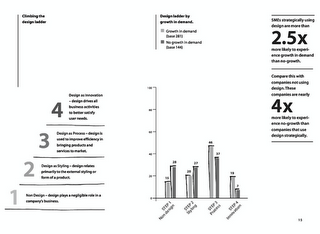The best defence in your business case for investment in design is the impact of design on the long-term financial value of the business. There are several reputable organisations that have spend quite some time and money to analyse how spending on design creates impact on the bottom line.

Interbrand have some fantastic international analysis on the Best Global Brands 2008 and they discuss how to value your brand based on future earnings using:
- Forecast financials
- Economic analysis
- How your brand influences ongoing consumer demand
The Design Council UK found in 2001 that a basket of companies using design grew by around 10% faster than the market. The Danish Design Centre found in 2006 that out of 800 companies (staff from 35-200) those that use design had growth in gross result (gross profit discussed above) of 250% compared with companies that did not.
In 1993 Roy R. and Potter S. (of the Open University in the UK) found in a study called Winning by Design that 94% of projects using design that were implemented achieved a positive net return. On average the payback period was 14.5 months. Interestingly, product design projects took 15.9 months to pay for themselves and graphics/packaging projects took 11.5 months.
The Irish Center for Design Innovation gets design and innovation in a big way and it’s worth pointing your finance team towards them to check out the financial models for assessing an investment in design.
Armed with your economic levers, your accounting impacts, the specific forecasts and some aggregate data to support your assumptions you are now ready to face your CFO.

